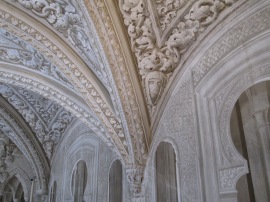Since it was a gorgeous day on Saturday, We explored the gorgeous landscape of Sintra. It is a UNESCO World Heritage site with royal residences scattered along the mountain top. Its historical buildings date from the 8th to 9th centuries.
The Castle of the Moors is one of the oldest structures, it was designed as a military outpost by the Arabs to protect the territory’s population. Despite the Moor Badajoz King’s transfer of these territories to secure an alliance with the Christian king (Alfonso VI) in 1031, and the castle ultimately surrendered in the Conquest of Lisbon (1147) to the forces of Alfonso Henriques.
Due to limited time, and the expenses associated with visiting each of these castles, we opted to visit the most well-known, the Pena National Palace. It is one of the best examples of 19th century Romanticism in the world.
It originated as a Chapel to “Our Lady of Pena” which was built as homage to the virgin mary after an apparition. In 1493, when King John II made a pilgrimage to the site, and his successor, King Manuel I, constructed a monastery there dedicated to the Order of Saint Jerome. The area was devastated by the Great Lisbon Earthquake, and left largely untouched until the fascinated Fernando II acquired the monastery and it’s surrounding area, and commissioned Baron Wilhelm Ludwig von Eschwege for the design. The last Queen of Portugal, Queen Amélia, was the last royal family member to stay at this palace before her exile.
When you first emerge from the palace steps, a dramatic and dark bay window greets you. It is a clear representation of the Neo-Gothic style, and presents an allegory for the creation of the world, utilizing the depiction of a newt.
As you progress through the castle, you can see the Islamic roots, this is particularly evident in the Arab Room which depicts domed ceilings decorated with intricate Arabesque detailing.
The palace does not uniformly draw its aesthetics from one style, rather it is an intentional eclectic merging of of Neo-Gothic, Neo-Manueline, Islamic and Neo-Renaissance architecture. Since I stem from a design background, it is awe-inspiring to note the time spent on such delicate details. It’s a shame that although we recognize architectural history as an art form, it is not practiced in the modern day. Yes, we continue to study the progression and origins of these classic styles, but it is becoming a lost art, much like the extinction of traditional crafts.
What are your thoughts on lost heritage? What can we do as a society to prevent the death of such vital history?



